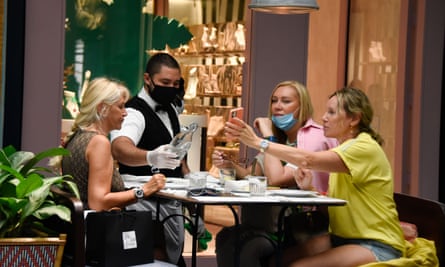Despite the inertia and dysfunction that plagued the early stages of the US government’s response to the coronavirus pandemic, the situation could still have been somewhat rescued if Donald Trump had merely backed the efforts of his own administration, public health experts say.
Instead Trump has shown little active leadership and frequently undermined government efforts and advice aimed at curbing the virus by encouraging reopening protests and refusing to wear a face mask.
As America pushes ahead with reopening businesses and allowing public gatherings even as Covid-19 infections have jumped to alarming new highs in a number of states, missed opportunities have severely undermined the recovery phase of a pandemic that has already claimed 116,000 lives in the US.
On 16 April, the White House issued guidelines to states on how to safely restart normal life again. Many epidemiologists saw them as flawed – too broad, still not backed with a robust system of testing and tracking infected people to prevent a resurgence of the virus – but it was at least something consistent to work to at a delicate stage of the pandemic.
Instead, Trump announced “we’re in the process of winning now” and the next day responded to protests demanding an immediate reopening by tweeting “LIBERATE MICHIGAN”, “LIBERATE MINNESOTA” and “LIBERATE VIRGINIA”.
From calling himself a wartime president fighting an invisible enemy, Trump, having seen some initial progress and a modest rebound in the stock market, vacated the battlefield, observers say.
An official close to the pandemic effort, who did not want to be named, said the federal response has been a “shitshow” with a leadership vacuum that Dr Deborah Birx, coordinator of the coronavirus taskforce; Jared Kushner, the president’s son-in-law; and Mike Pence have all tried to fill.
“Trump had a plan from Dr Birx and if he had asked for a little more patience from the public we’d have a very different situation to now,” said Andy Slavitt, former acting head of Medicare and Medicaid Services. “But he was unwilling to do that. He couldn’t wait.
“There’s no science saying taking a month off ends the virus. The way the virus works is that it goes to places it hasn’t been and infects people, and that’s happening again now. No one has an easy job in this and there are tough decisions to make, but that’s where you need leadership. We’ve lacked that.”
Another potential turning point arrived earlier in the crisis, on 3 April, when the Centers for Disease Control and Prevention (CDC), which has been largely sidelined during the pandemic, advised Americans to wear cloth face coverings. Again, the advisory was not perfect – surgical masks are far more effective but were in short supply because of a deficient federal stockpile.
Public health researchers have found, however, that even homemade masks can prevent Covid-19 spreading through coughing and sneezing and with Republican men far less likely to wear masks than other groups, a strong endorsement of the CDC advice from Trump could have pushed mass mask wearing and cut the pandemic off at the knees.
But Trump revealed he would not be wearing a mask himself, and pondered “sitting in the Oval Office behind that beautiful Resolute Desk, the great Resolute Desk, I think wearing a face mask as I greet presidents, prime ministers, dictators, kings, queens, I don’t know, somehow I don’t see it for myself”.
He subsequently removed a mask he was wearing during a tour of a factory in Michigan to avoid the media seeing him in one.
“There’s been a complete failing in the national response and to recommend mask wearing and then undermine it in the same press conference is the epitome of what’s gone wrong,” said Tom Frieden, former head of the CDC.
Slavitt pointed out that countries such as the Czech Republic and New Zealand, which instituted strong, consistent measures, have been able to emerge from the pandemic without mask wearing. “Trump could’ve worn a mask for four weeks, asked people on the other side of the aisle to do the same and you’d get a dramatic reduction in the infection rate and start to operate very close to normal again,” he said.
“He would have a booming economy, very little virus and the closed borders, which he wants anyway. The public can take hard news if they are being given it straight but Trump doesn’t do bad news. He can’t do the little bit of sacrifice to see it through,” Slavitt added.
As the White House’s visible pandemic response has eroded – the coronavirus taskforce has not held a briefing for nearly two months – it’s been left to the states to time the reopenings of restaurants, bars, retailers and other public spaces. Infections are now trending upwards in 18 states, with evidence that a restart in travel and interactions between people is driving the increasing numbers, along with expanded testing.
Arizona is a new Covid-19 hotspot, with two weeks of record high infections, prompting Kate Gallego, the mayor of Phoenix, to warn that “hospitals are really struggling” with the influx of new patients.
New Covid cases nearly doubled in Alabama after reopening while in Florida a state record 2,581 new infections were confirmed on Saturday, breaking the previous high from just a day previously, two weeks after the state allowed the reopening of bars, movie theaters and other entertainment venues.

Overseas, countries such as New Zealand have instituted a traffic light-style system to inform the public of increasing danger and dial restrictions up or down in response. US epidemiologists have also looked enviously at the data dashboards used in places such as Singapore, which track infection cases from contact between people. While some states, such as Oregon, have paused reopenings due to an increase in cases, many others are pushing ahead regardless, citing the economic and mental health costs of continued lockdown.
“Americans are on the move, and they can’t be tied down, and they can’t be restrained unless they make a voluntary decision that this is right for me and my health or my family,” said Asa Hutchinson, governor of Arkansas.
Some Republicans have expressed frustration over what they see as a hypocritical reaction to the anti-racism protests that have roiled the US in the wake of George Floyd’s death, pointing out these gatherings may well have spread the virus. The fallout from the protests and conservatives’ reluctance to isolate further will probably make it extremely challenging to reimpose lockdown should infections escalate.
“Shutting down is not the answer,” said Henry McMaster, governor of South Carolina, last week, even after his state epidemiologist warned she was more worried than ever about the spread of Covid-19 in South Carolina. “People have to be able to go and work for a living.”
Frieden said that states with declining cases may seek to restrict travel from those with soaring infection rates, while pushing what he calls the three Ws – washing hands, wearing masks and watching your distance – to avoid an explosive spread.
“Predicting the future is a risky undertaking, though,” he said, “People are very reluctant to go back into lockdown, although some people will want to stay home. We do need to realize, though, that public health isn’t the barrier to reopening, it’s the route to reopening.”
Source: US Politics - theguardian.com



